Like many people, I have tons of wild strawberry running through my yard and gardens. Or at least, I have what I grew up calling wild strawberry. In fact, it isn’t a strawberry at all. Instead, what I have is mock strawberry (Potentilla indica) and that’s what most people I talk to have in their yards and gardens. We’ll talk more about it later.
In the eastern U.S., we have two species of native wild strawberries. Both produce small, sweet berries. The most common of the two species and the one with the largest native range is the Virginia strawberry (Fragaria virginiana).
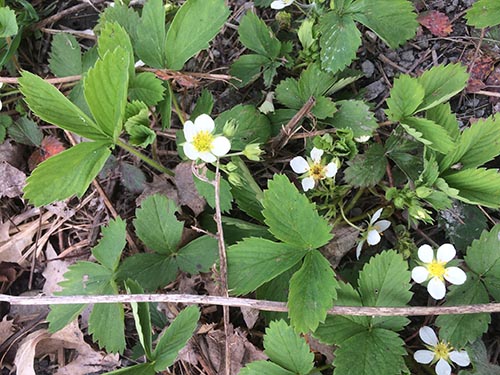
Native range
Virginia strawberry is found throughout most of the eastern U.S. and in parts of the western U.S.
Biology and Life History
Like all strawberries, Virginia strawberry is in the Rosaceae family along with blackberries, apples, plums, and many of our other favorite fruits. It blooms in April and May and has bright white flowers. Then in early summer it produces small, roundish strawberries. The berries are reported to be very delicious if you can beat the critters to them.
Each individual plant is only around 4-9 inches tall. They can spread by the seeds in their berries, but they primarily spread by vegetative runners. Virginia strawberries are most often found in fields and other open areas.
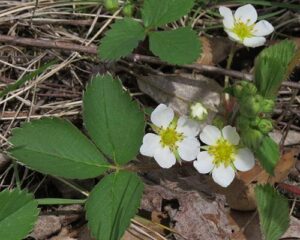
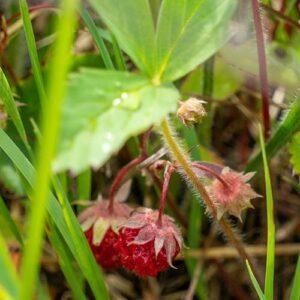
How to Identify Virginia Strawberry
Both of our native strawberries have WHITE flowers. This is an important distinction from the look-a-like that many of us have growing in our yards and gardens. You can tell Virginia strawberry from the less widespread, but also native, woodland strawberry (Fragaria vesca) by looking at the leaves and at the fruit.
Virginia strawberry has small, roundish fruits with the seeds embedded in the skin. This means that the strawberries feel relatively smooth and not extremely bumpy. Also, when you look at the tip of a Virginia strawberry leaf, the last tooth at the tip will be smaller than the surrounding teeth.
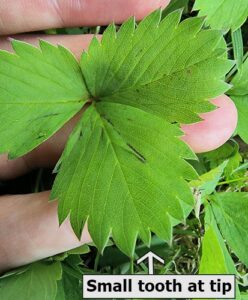
Pollinator and Wildlife Uses
Pollinators and wildlife are highly attracted to Virginia strawberry. A wide variety of mammals including deer, rabbits, and groundhogs will eat the leaves. In addition, up to 68 species of caterpillars, including those of the gray hairstreak butterfly and the purple lined sallow moth, use our native wild strawberries as host plants.
The flowers are visited by a number of native bees and smaller adult butterflies and skippers. Then, of course, pretty much everything will feast upon the berries including black bears, squirrels, opossums, brown thrashers, American robins, other song birds, box turtles, and wood turtles.
Incorporating Virginia Strawberry into Your Yard
Virginia strawberry can make an amazing groundcover intermixed with other native plants in a garden setting. They do best in sunny to partly sunny areas with well drained soil. This means they can also be interspersed in your yard to provide more diversity than just turf grass.
Virginia strawberries can be hard to start from seed and are most easily propagated by allowing their runners to root. Newly sprouted runners can be easily dug up and snipped from the mother plant, then relocated to a new location on your property or given to friends.
Beware a Common Look-a-like
Now, let’s talk a bit about the look-a-like that is so often found in yards and gardens and which many of us grew up calling a wild strawberry. That plant has YELLOW flowers and is the mock strawberry (Potentilla indica).
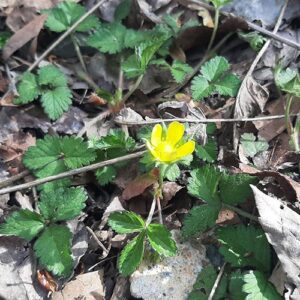
Mock strawberry is an introduced species that is native to India. It can now be found across the eastern U.S. and parts of southern Canada. In many areas, mock strawberry is considered an invasive species because it spreads so rapidly and can form dense mats that can choke out other plants.
At first glance, mock strawberry looks a lot like an actual strawberry plant which is why it is so often confused with our native wild strawberries. However, true strawberries have white flowers while the mock strawberry has yellow flowers. The fruits are also different. Mock strawberry fruits form pointing up towards the sky, are very visible, and have knobs or bumps all over them. However, Virginia strawberry fruits hang down from the plant, may be hidden by some of the leaves, and are relatively smooth.
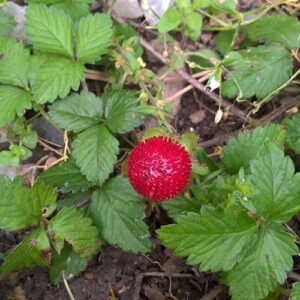
Mock strawberry fruits tend to be dry, seedy, and generally have little to no flavor. This is in stark contrast to the fruits of Virginia strawberry or our other native, wild strawberry species. Most critters tend to avoid mock strawberry and very little eats either its vegetation or the fruit it produces.
Summary
Virginia strawberry is fairly wide spread throughout much of the eastern U.S. It is highly sought after by a wide variety of pollinators and wildlife for its vegetation, flowers, and fruit. Because it is easy to grow, spreads quickly by runners, and stays short, it can make a great ground cover or living green mulch for native plant or pollinator gardens. It can also be allowed to grow intermixed with the grass in your lawn, just like mock strawberry often does. But Virginia strawberry will provide much greater value for your local pollinators and wildlife than the familiar look-a-like mock strawberry.
If you would like personalized help creating your own pollinator and wildlife habitat, then we encourage you to check out the Backyard Ecology™ Community.
There’s lots of great “big picture” information available about creating pollinator gardens or larger habitats for pollinators and wildlife. What’s lacking are opportunities to say, “This is what I want to do. This is what I’m struggling with. How do I make it work on my property?”
That’s part of what the Backyard Ecology™ Community offers its members every day.
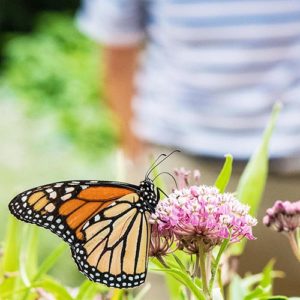
Thank you!
These amazing individuals go above and beyond every month to provide financial support which helps us create so much free content for everyone to enjoy and learn from.
Julie Krygier, Lizabeth, Russel Furnari, Crystal Robinson, Karen Veleta, Kevin B, Sally Mirick, Crystal Dyamonds, Mitchell Bell, Laura Hunt, Sue Ann Barnes, Adrienne Richardson, J. Adam Perkey, Ariel, Cara Flinn, David Todd, Cathy, Michael, Tom Winner, Eric Fleming, Julie, SB H, Christopher Scully, Craig, Rachel Antonucci, Melissa Egbertson, Switzy, CotswoldsCottageMA, Vilma Fabre, Pia O Nomata, Linda McNees, HerculesBiggerCousin, Patrick Dwyer, Paul Gourley, Lilith Jones, John Master, William Morin, Lori Sadie Ann, Debra, Ayn Zitzman, Han Mad, Isaac Kowis, Cathy Anderson, Betsy Lessels, Reid, Dave Teare, Debra Moore, and Tyler Dowdy.
Backyard Ecology™: Creating thriving backyard ecosystems that you can enjoy and be proud of
We created Backyard Ecology™ to help you confidently create pollinator and wildlife habitat that you can enjoy and be proud of. Because nature isn’t just “out there.” It’s all around us, including right outside our doors.
Our focus on the eastern U.S. means that the information we share is applicable to you and where you live. Join us as we ignite our curiosity and natural wonder, explore our yards and communities, and improve our local pollinator and wildlife habitat.
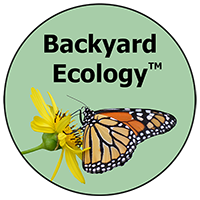
Backyard Ecology™’s Guiding Principles:
🦋 Curiosity: Nature is fun, interesting, and worth exploring. We will never know everything. Answers lead to more questions. That’s half the fun.
🦋 Balanced: You don’t have to choose. You can support nature AND have a beautiful property that you can enjoy and be proud of.
🦋 Science informed: Habitat creation and management should be based on the latest scientific research available. This is true regardless of whether you’re working in a small garden or on hundreds of acres.
🦋 Stewardship: Anyone can make a positive difference in the natural world and leave an ecological legacy on their property.
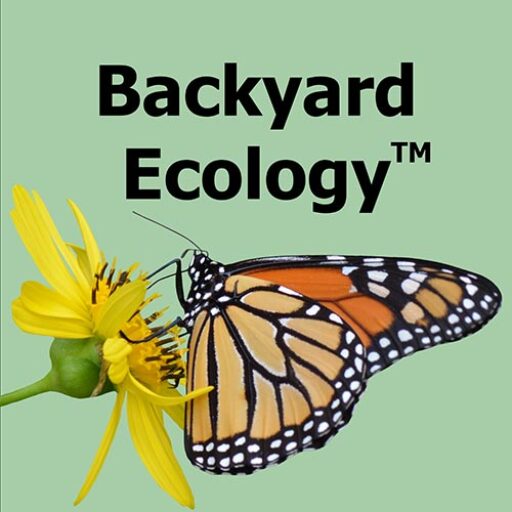
Leave a Reply